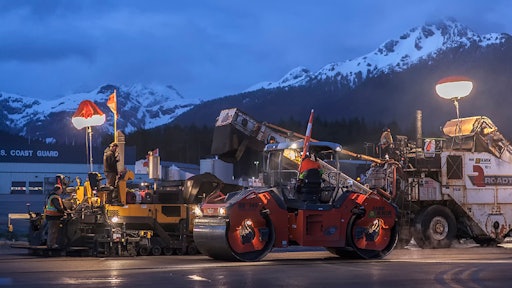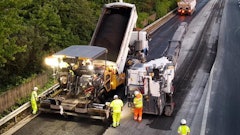
There have been many advancements in Intelligent Compaction (IC) over the past few years aimed at reducing the guesswork in the paving process. In fact, the Federal Highway Administration (FHWA) continues to work with many states and manufacturers to enhance IC systems that provide real-time information to the operator that’s critical to achieving target density. These factors include number of passes, mat temperature and Intelligent Compaction Measurement Value (ICMV) — each allowing operators to make informed decisions on the fly.
But not all IC systems solely measure ICMV. Some systems can deliver real-time, in-place density calculations — taking ICMV a step further. Here’s a breakdown of the difference.
WHAT IS INTELLIGENT COMPACTION MEASUREMENT VALUE?
Intelligent Compaction Measurement Value is a broad industry term for a measure of stiffness that’s calculated using accelerometer measurements on vibratory compactors. ICMV isn’t a measure of density itself — it’s a value used in the calculation of it.
In 2014, the FHWA released a report that attempted to identify a clear correlation between ICMV calculations and in-place asphalt densities. The report found that ICMV values alone can’t reliably estimate core densities, stating, “The pass-by-pass ICMV correlate well with nuclear density gauge measurements during breakdown compaction. The final ICMV does not correlate well with core densities.”
There are numerous factors cited in the lack of correlation including measurement depths, footprints and a change in drum rebounds when asphalt temperatures drop below a certain threshold. The report does, however, insist that IC systems “can be used as an enhanced tool for quality control by monitoring ICMV in real time during construction to maximize the window of opportunity for compaction.”
According to the FHWA, the greatest strengths of using IC equipment include:
- Real-time data of pass counts. There are many reasons why the real time data collected with GPS equipment is so beneficial. It almost eliminates the possibility of missing areas of the asphalt mat during rolling. This helps to achieve consistent densities. The pass count mapping is particularly useful during night paving where roller lines are difficult to see. It also works as an excellent training tool for less experienced roller operators.
- Real-time data of asphalt temperature. This ensures that the temperature of the mat behind the paver is uniform. This is also critical for achieving consistent densities.
- Records of all roller settings (speed, frequency, amplitude), pass counts, and temperatures. If there are any issues with achieving asphalt density, these factors can be viewed and used to identify potential issues with the rolling operation.
- Ability to identify weak spots in the existing surface prior to paving by pre-mapping. This is helpful when preparing the sub base/base course layers. Alternatively, it is also a great tool if the Contractor did not prepare the existing surface to be paved.
HOW INTELLIGENT COMPACTION WORKS
Intelligent Compaction systems feature an accelerometer-based measurement system, as well as GPS, infrared temperature sensors, and an on-board computer that provides real-time compaction information to the operator. The primary features of IC systems — common among all providers — are pass mapping, surface temperature mapping and data collection.
- Pass Mapping — IC systems provide real-time information to the operator, showing how many passes have been completed and ensuring the operator can gain better uniformity across 100% of the mat. Over-compaction is equally as detrimental to quality as under-compaction, and pass mapping can help ensure the operator isn’t making too many or too few passes.
- Temperature Mapping — IC systems display real-time pavement surface temperature information to the operator. This is incredibly important, as the temperature greatly impacts the material’s ability to be compacted. Armed with real-time temperature information, a skilled compactor operator will know to make adjustments to compact the asphalt at peak temperatures and avoid the need for additional passes that can drive up project costs and extend timelines.
- Data collection — The FHWA recognizes that IC data could provide significant value for quality control protocols, so one important factor is ensuring that data is collected and reported in a standard format among all manufacturers’ IC systems.
While these three features are more or less standard across all IC systems, what varies significantly between systems is how the asphalt ICMV is calculated. Most IC systems offer real-time asphalt ICMV calculations; however, each manufacturer has a slightly different methodology for how it’s done. Despite the variance in calculations between manufacturers, each has the same goal in mind — to equate ICMV to density.
THE BUSINESS ADVANTAGES OF REAL-TIME DENSITY CALCULATIONS
Asphalt contractors who use Intelligent Compaction are in a better position to win DOT bids and are better able to make quality control decisions on the fly. Those with real-time density calculations at their fingertips have the added advantage of a proven correlation to core densities as compared to these other systems.
According to the FHWA, " IC seems like an obvious solution to ensure that the entire asphalt mat gets the correct amount of compaction effort."
As the necessity for IC grows, contractors need to familiarize themselves with the technology to stay competitive. In 2017, 23 states had developed asphalt IC specifications. There were nine states at that time that developed soils IC specifications. Caltrans also developed an IC specification for cold in-place recycling (CIR). PennDOT includes roller compacted concrete in their IC specifications. The use of this technology has exploded since then.
Multiple states have already adopted IC specifications and are mandating that road contractors use IC systems on certain projects. This number is only expected to grow. Road contractors who have demonstrated experience with IC systems will have a clear advantage working on DOT jobs with IC specifications.
HOW TO GET REAL-TIME DENSITY VALUES
It's a well known fact that the more even and high-quality compaction is for both soil and asphalt, the more durable and long-lasting the streets and buildings constructed upon it will be. For this reason, manufacturers have been working hard to ensure contractors have the best tools at their disposal for getting accurate compaction in real-time.
Volvo Compact Assist with Density Direct is an alternative method to predicting density. As with other IC systems, Density Direct offers surface temperature mapping, pass mapping and data collection capabilities via the Volvo Co-Pilot display. However, the Volvo system offers the added benefit of real-time density calculations. At the touch of a screen, the compactor operator can see the predicted density of the material being compacted, and unlike ICMV values, which are unitless, Density Direct data is expressed on a scale of percentage of air voids removed.
Within the Density Direct system is a screen where the user sets up the system for a calibration test strip. After starting calibration, the system automatically plots the area for the operator to cover with four vibratory passes. These passes are used to train the system’s artificial neural network. When complete, the calibration is saved, and the Co-Pilot will display predicted density as a percentage. For best accuracy, pavement core samples are taken from the calibration strip (after final compaction) and tested in a laboratory. These values can then be put into the calibration to increase accuracy of the predicted density. ICMV does not require calibration, but it also does not correlate easily to density results.
The user interface of Volvo Compact Assist with Density Direct depicts a density map, showing each square unit of rolled surface in a color representing predicted density. It also provides real-time numerical readings of predicted density that come from an average across the width of the drum, surface temperature and pass count displayed on one side of the screen. The user can also toggle between density mapping, surface temperature mapping and pass mapping. The pass mapping function captures each compactor pass and drum overlap with a different color so the operator can easily see gaps and work to maintain uniform coverage. Temperature mapping shows the operator the path of the compactor overlaid with the recorded surface temperature.
HAMM has released HAMM HCQ as a part of their WITOS of Compaction Suite. HAMM HCQ enables the compaction progress to be monitored – in real time as well as remotely. For example, construction managers will be able to obtain comprehensive information on the progress of construction at any time without having to be on site. They will be able to control processes from the office and take decisions on the basis of qualified information. This in turn brings savings in travel time and costs and enables quality improvements to be achieved through timely interventions.
The Hamm Measurement Value (HMV) is the Intelligent Compaction Measurement Value (ICMV), or stiffness index for the Hamm/Wirtgen IC equipment. The HMV values vary drastically based on roller speed, frequency, and amplitude settings.
HAMM also sees the potential for even greater efficiency in the optimization of machine utilization with the aid of WITOS FleetView. It facilitates maintenance and diagnostics, speeds up response times in the event of faults and also enables systematic analyses of operating and user behavior. Finally, regular maintenance and timely, cost-optimizing replacement of wearing parts increases roller availability. At the same time, unscheduled downtimes, often involving transport costs and organizational work, are avoided.
In early 2019, BOMAG advanced the compaction industry with the introduction of its BOMAP app, a free digital solution designed to deliver an easily accessible intelligent compaction solution for both soil and asphalt projects. Now, the company has taken compaction even further down the digital road with the launch of BOMAG Connect, a substantial enhancement that enables networked control and documentation of all compaction equipment involved in the compaction process.
With the help of planning data and up-to-date information from online map services, this subscription-based cloud solution makes it possible to specify all relevant core parameters for the site and plan the compaction process in detail. Respective job areas can be defined and compaction specs set according to task (number of passes or soil compaction value or material stiffness). Machines can be assigned to projects and tasks for optimal results. Roller operators, project supervisor and site managers can monitor and track all compaction values in real time.
After activating an Android tablet or smartphone in a BOMAG roller, the installed free BOMAP app connects to the machine interface and registers the machine parameters. All data relevant to compaction (e.g., material stiffness or temperature) is automatically recorded and transmitted through the cloud to BOMAP Connect. Third-party machines also interconnect and can transmit their passes, helping to generate a pass map for the entire site.
Within seconds, this data is combined in real time and displayed as a color-coded map. Colored areas indicate the compaction results achieved by the entire roller fleet. Operators can readily see areas that have already achieved target material densities, the current degree of compaction in a specific area and their position on the asphalt mat or soil section.
As the technology behind compaction progresses, contractors will be required provide detailed, comprehensive compaction measurements. Adopt these tools now and stay ahead of the learning curve associated with compaction technology.
Mark Eckert is Global Product Manager at Volvo Construction Equipment



























